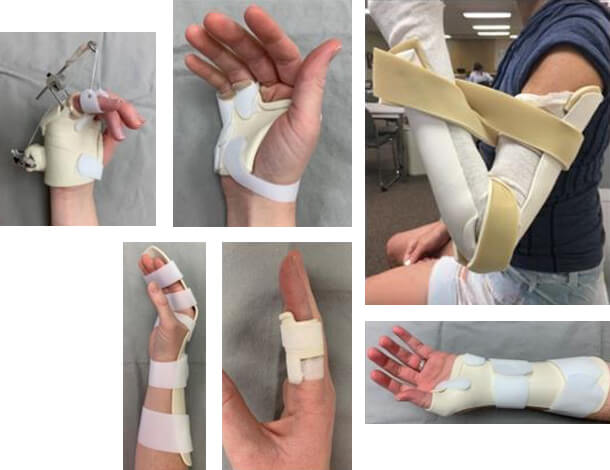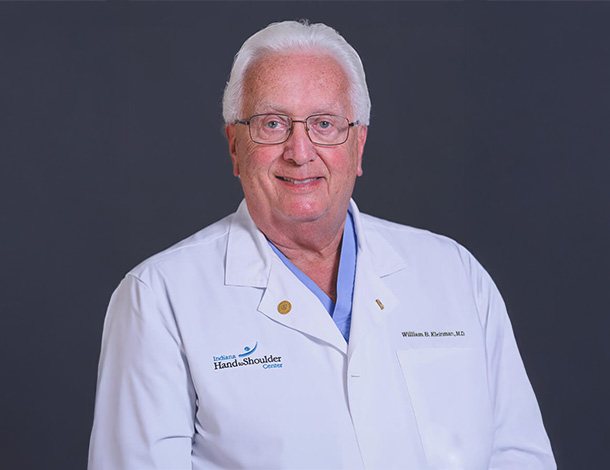Custom Orthoses in Hand Therapy: Types, Benefits, and Uses

Specialists often prescribe custom orthoses to provide the support or immobilization needed to help heal weak, injured, or deformed muscles, joints, and bones. Custom-fabricated orthoses also help patients continue daily activities without compromising their recovery from an illness or acute injury.
If part of your comprehensive, personalized recovery plan, a qualified practitioner (e.g., a hand therapist) will mold your orthosis to fit like a glove—literally. This individualization is critical because your upper extremity’s anatomy is as unique as your fingerprint, requiring tailored medical treatment for the best outcome.
Keep reading to learn more about different types of custom orthoses, including their benefits, fabrication details, common use examples, and more.
What Is an Orthosis?
According to the American Society of Hand Therapists, an “orthosis is the proper term that applies to a custom-fabricated brace/splint … that supports, restricts, or eliminates motion in a diseased or injured part of the body.”
Simply put, custom orthoses are made-to-fit medical devices created by qualified practitioners to provide stability during healing. Designs range from slip-on braces to devices with coils, springs, and elastic bands.
Benefits
A custom orthosis is finely tuned to address only your injury. It provides the highest level of healing through enhanced, targeted support and the most specificity for complex problems, all while protecting against further injury, speeding up recovery, and maximizing comfort. Custom devices are also adjustable as rehabilitation progresses, ensuring your comfort and safety throughout your healing journey.
While each custom orthosis is unique, the advantages are universal:
- Fit Designed for Durability and Targeted Protection or Compression
- Precise Positioning to Provide the Greatest Level of Function While Healing
- Faster Recovery Time and More Comprehensive Healing
- Adjustable for Increased Comfort
Materials and Design
A hand therapist typically creates a custom orthosis using a pliable thermoplastic material, warming it with gentle heat. Then, they mold it onto their patient’s affected body part, which cools around the area’s unique contours. The final product is rigid or semi-rigid. This process ensures a perfect fit and maximum comfort for the patient.
Some designs incorporate moving parts for performing range-of-motion exercises.
Compared to over-the-counter braces, custom-made orthoses stay in place better, fit precisely, and provide targeted support for enhanced healing. The precision fit prevents dangerous movements that cause further injury or discomfort.
Unlike casts, custom orthoses can be designed around wounds from injuries that you must clean. And, as a bonus, most custom orthoses feature high-quality fasteners to minimize the potential dread of taking them off to do rehab exercises.
Different Types of Custom Orthoses
Orthoses can be strategically designed to support a patient’s healing needs and activity level. Some examples of common orthoses include:
- Thumb Spica Orthosis (Radial Gutter Splint)
- Wrist Cock-Up Orthosis (Dorsal Wrist Splint)
- Ulnar Gutter Orthosis
- Resting Hand Orthosis (Functional Hand Orthosis)
- Dynamic Finger Extension Orthosis
- Dynamic Pronation/Supination Orthosis
- Elbow Extension Orthosis
- Tip Protector Orthosis
- Muenster Orthosis
Orthoses for the upper extremities fall into two categories:
- Immobilization
- Mobilization
What Is a Custom Immobilization Orthosis?
A static or immobilization orthosis is a custom-fitted orthosis with no moving parts. It restrains, protects, and corrects the position of an injured area so it can rest. Patients with injuries like fractures and sprains heal best with custom-made immobilization orthoses.
Example: Ulnar Gutter Orthosis
This type of hand immobilization orthosis stabilizes broken metacarpal bones that run from the wrist to the pinky and ring fingers. A custom-designed orthosis provides a precise fit to promote proper and effective healing while maximizing wrist motion and comfort.
What Is a Custom Mobilization Orthosis?
A dynamic orthosis allows tight joints and muscles to move while correcting or maintaining alignment using low-load, long-duration stretch.
A custom-created mobilization orthosis might have moving components for performing controlled exercises. They are often used after acute injuries when stiffness develops during immobilization while the bone heals.
Example: Dynamic Wrist Flexion Orthosis
This type of orthosis reduces stiffness from a wrist or forearm injury. It gives a patient an increased range of motion so they can perform low-load, long-duration stretches. A custom version provides the best fit with exacting angles of pull and comfort for safe therapeutic exercise.
FAQs About Custom Orthoses
Here are three starter questions that patients might have about custom splints.
How Long Do I Need to Wear My Custom Orthosis?
The duration of use depends on many factors, such as the severity and complexity of the injury, the type of injury, and how quickly your body heals.
Typically, custom-fitted orthoses are worn for a few weeks to a few months. Your hand therapist will likely adjust the time as treatment progresses to deliver the best outcome—if you stop using it too soon, you could risk reinjury; too late, weakness can set in.
Can Custom Orthoses Be Used for Sports Injuries?
Yes, depending on the issue. Wrists, thumbs, and fingers take a beating in athletic competition. Custom-fabricated orthotics are often used for sports-related injuries like fractures, sprains, and tendonitis. They ensure proper healing while allowing some level of activity.
What Are the Alternatives to Wearing a Custom Orthosis?
While custom orthoses provide the safest and most complete healing in many cases, prefabricated (or off-the-shelf) braces and bandages can be sufficient for less severe injuries or conditions or when custom options aren’t quickly attainable.
Some specialists who provide custom orthoses also use prefabricated orthoses, when appropriate, that are custom-fitted. Off-the-shelf splint options sold in pharmacies lack the precise fit and support of custom orthosis and may be less effective.
Without proper stabilization, injured areas can take longer to heal and cause swelling, discomfort, additional pressure points, and long-term complications. Specialists might also recommend a cast for some fractures. Consult a doctor about your best option.
Benefits of Custom-Designed and Fabricated Orthoses
Custom orthoses can be an affordable and accessible option for lasting pain relief and injury rehabilitation. The precise fit enhances every part of the healing process and maximizes comfort and continued functionality so you can focus on getting better.
Custom-fitted orthoses can ease the day-to-day burden—and frustration—that accompany pain and distress by speeding recovery and safely preserving the use of your upper extremity during recovery.
Get Your Orthosis at Indiana Hand to Shoulder Therapy Center
At the Indiana Hand to Shoulder Therapy Center, we understand that life goes on while you work hard to recover from an injury.
Custom orthoses were a critical part of our patient Kay’s recovery from a car accident that left her with a broken wrist and shattered clavicle. “IHTSC are specialists, so they made everything I needed right there on site,” she said. “About one year later, I am so glad to have almost complete function of my right hand back after my wrist fracture.”
If you or someone you love needs a custom orthosis, we can help. Contact us when you’re ready to explore options with our occupational therapy team. Our experts provide unmatched expertise in all aspects of hand therapy, including designing and creating custom orthoses.
Call (317) 875-9105 to book an appointment or schedule online.
You Might Also Like:
Disclaimer: The materials on this website have been prepared for informational purposes only and do not constitute advice. You should not act or rely upon any medical information on this website without a physician’s advice. The information contained within this website is not intended to serve as a substitution for a thorough examination from a qualified healthcare provider. The display of this information is not intended to create a health care provider-patient relationship between the Indiana Hand to Shoulder Center and you.



